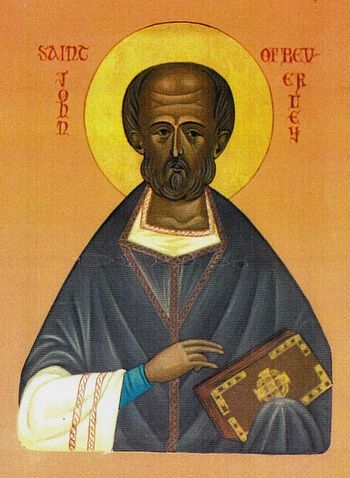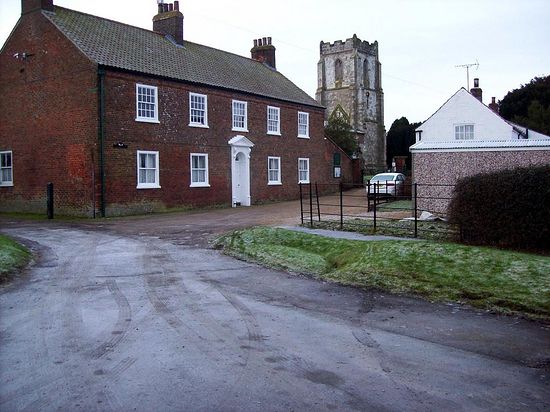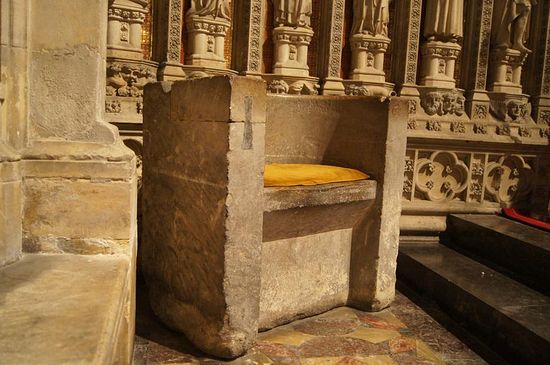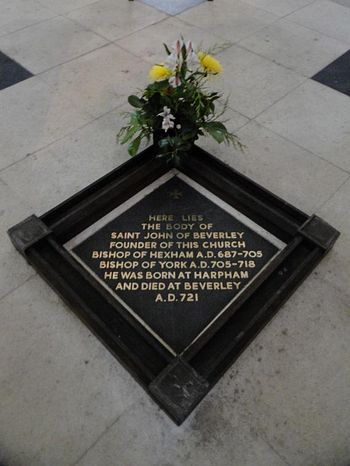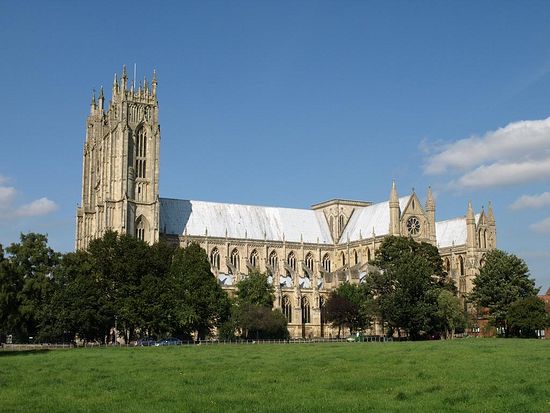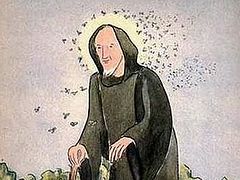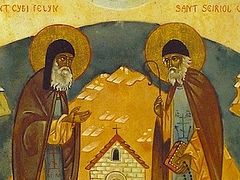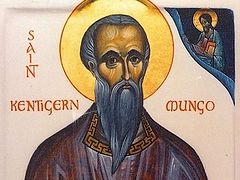St. John of Beverley (+721) is a great saint of the golden age of saints in England, yet he is not so well known as other saints of that time, even though we have more details about his life than many other saints. Most of these details we find in that great work of St Bede “the Venerable” (+735), the Ecclesiastical History of the English People which he completed in 731. Ironically, little is known of the life of St. Bede, who spent his life as a monk in the monastery at Jarrow near Newcastle upon Tyne in the north-east of England, 100 kilometres south of the Holy Island of Lindisfarne. We do know, though, that St Bede was ordained a deacon and later priest by St. John. Other ancient sources add further details to the life of St. John, so that we have as full a picture of him as could be expected from so long ago.
St. John was born about 640 at Harpham in Yorkshire of a noble Saxon family. Harpham is a small village near the north-east coast of England, being 55 kilometres east of the City of York and 30 kilometres north of the town of Beverley. His pious parents must have been Christian since they ensured that he was educated in the Christian faith. St. Bede tells us that St. John undertook further studies with St Hilda at the great monastery she founded at Whitby on England’s northeast coast. One tradition has it that St. John studied at the Canterbury School founded by St Theodore of Tarsus, who had arrived in England from Rome in 669 to be Archbishop of Canterbury.
St. John left Whitby and retired to a place of retreat
near the River Tyne, spending his time in prayer and
meditation. However, his love and compassion for the
people led him to leave his solitude and go to preach and
minister to the people of the area. It was from this time
that miracles were worked by God through St. John. In a
certain village, a boy who was dumb and suffered from a
diseased scalp was brought to the saint who made the sign
of the Cross on the boy’s tongue which was
immediately loosened. St. John, not neglecting the
boy’s practical need, then trained him how to speak.
He also instructed a physician how to treat the
boy’s scalp which, by the saint’s prayers, he
did successfully.
In 687, St. Theodore consecrated St. John Bishop of Hexham in succession to St. Eata and where St Cuthbert had been Bishop from 684 to 685. St. John administered his diocese with all proper care, travelling everywhere and not forgetting even the smallest community. He ordained St. Bede as deacon, perhaps in 692, and then as priest nine years later. In 705, St. John was consecrated Bishop of York. This city was called Eboracum by the Romans and it was here that St. Constantine was proclaimed Roman Emperor in 306. In 314, the city had sent its bishop to the Council of Arles. The diocese must have disappeared after the Romans left and it was renewed when St. Paulinus, sent to England by St Gregory the Dialogist, became Bishop of York in 626. It was not, however, called York until the Vikings settled in the region from 866. St. John was the fifth Bishop of York; it is sometimes wrongly said that St. John was Archbishop but York did not become an archdiocese until 735. In his diocese, he cared constantly for his flock, and did more miracles of healing. At the convent of Walton near Beverley, the Abbess, full of faith, begged St. John to pray for a nun who was near to death. He went to the convent and blessed the sick nun. Later, when the community was at the dining table, word came that the nun was recovered, and all gave thanks to God.
On another occasion, St. John was asked to visit the house of a nobleman whose wife was seriously ill. The holy servant of God gave orders that water he had blessed be given to the woman. Her recovery was instant, her former strength returned and she was able to join the company and serve them, following the example of St Peter’s mother-in-law. When the holy Bishop was asked by a nobleman called Addi to consecrate a church on his land, he did so, and then was asked by Addi to visit a young servant who was close to death. So serious was the boy’s condition that the coffin was in the room ready to receive his body. Soon after the saint prayed for him, the boy recovered and lived in good health for many years.
St. John organized the training and education of the young men in his area. One such was called Heribald. One day when a company of young men was out riding their horses, they decided to have a race. St. John forbade Heribald to take part but he was tempted and disobeyed him. Heribald fell from his horse and his skull was crushed. The holy Bishop was full of grief for the young man and spent the whole night in prayer. The next day, Heribald felt a little better, but then St. John learned that the young man had not had valid baptism. The man of God breathed upon him and Heribald immediately felt better, and in fact recovered so quickly that he was able to travel the day after. Heribald was later ordained and became abbot of a monastery.
As part of his organisation of the education of young men, St. John founded Beverley Grammar School in the year 700. The school is the oldest state high school in England and has an excellent reputation, especially in practical subjects such as the sciences, so continuing the tradition begun by St. John.
Towards the end of his episcopal ministry, St. John would often go secretly at night to a chapel to pray. On one such occasion, his deacon, Sigga, looked through a hole in the chapel door and saw the saint at prayer with the divine light blazing above his head and the Holy Spirit like a dove above him. Sigga’s face was scorched by the light and heat, and St. John heard his cries of pain. Taking Sigga into the chapel, he touched his face which was immediately healed. He told Sigga not to tell of this until after he, St. John, had died.
In later years, the holy Bishop found it necessary to retire and so he left York and founded a monastery at Beverley in 714. There is a tangible link with St. John, because his bishop’s throne still is situated in the Minster. For many centuries, this chair, called the Frid Stool or ‘peace chair’, was a place of sanctuary where those fleeing from the law could find safety.
In his monastery, in 721, St. John ended his life in this world. The town of Beverley grew up around the monastery, and in the 13th century, the present magnificent church, Beverley Minster, was built. In the centuries which followed, the saint’s tomb at Beverley was a place of pilgrimage for kings and simple people. His monastery church was rebuilt and still stands as one of the most beautiful early churches in England. In 1548, King Henry VIII ordered the destruction of the shrine and the closing of the monastery. The saint’s relics were preserved and later buried simply under the floor of the church.
God knows the help the faithful need in our times, and in 1997, an English convert to Holy Orthodoxy and his wife, finding the place where the saint’s relics were buried, went there to pray. As they did so, a beautiful fragrance arose from the spot where the sacred relics are buried. The couple’s spiritual father blessed them to tell what happened so that the faithful might take courage, knowing that the saints of Orthodox England acknowledge the veneration given to them.
Troparion tone 4
We acclaim thee, beloved Bishop John, righteous shepherd of souls, friend of the needy, healer of the sick, and pattern of monastic striving; O blessed adornment of Beverley, who wast invoked by kings and the lowly alike, we of these present times beseech thee, blessed father, entreat Christ God that we be granted great mercy.
Kontakion tone 5
Thou didst receive from heaven divine grace, O holy father John, and wast truly a vessel of light; wherefore it is meet for us to honour thee, revered hierarch, who by a sweet fragrance hast been revealed to us who now venerate thy memory and cry: Glory to God Who hath sanctified thee.
Holy Bishop John: pray to God for us!

